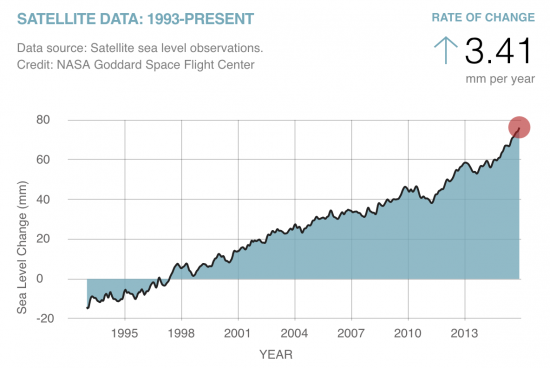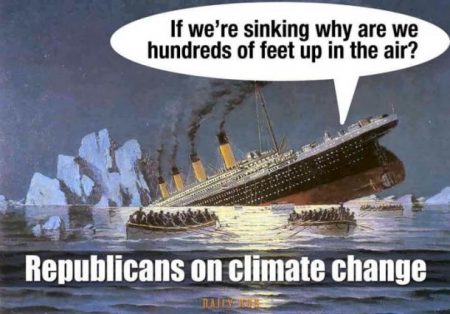May 27, 2017 – The G7 (Group of Seven) meetings in Italy will end today with a communique of common action by its members representing the world’s largest democratic economies. The absence of a consensus on collective action to deal with climate change is all about the great hoax himself, President Trump, who presents “belief” over “fact” in his approach to almost every issue of importance to the world today. The wording of the joint communique indicates that Canada, France, Germany, Italy, Japan, the United Kingdom, and the European Union’s leaders remain committed to reducing their collective carbon footprint. The United States, however, refuses to join the consensus.
As for “belief” versus “fact,” the latest research report appearing in the journal Proceedings of the National Academy of Sciences provides new evidence on the rate of ocean sea level rise. Prior to 1990, the average rise was 1.1 millimeters per year. From 1990 to 2012 the rate increased to 3.1 millimeters annually (about 1.2 inches per decade). The research also points out that calculations of sea level rise prior to 1990 were underestimated.

The research also points out that calculations of sea level rise prior to 1990 were underestimated. Prior research studied data from tide gauges around the world, considered a less rigorous source for accurate calculations. The new research used satellite data to give scientists a much more accurate view of the state of the ocean. The picture it paints is far more calamitous.
Unlike King Canute who purportedly sat on a beach as the tide rose to show his courtiers that he did not rule the waves, the new king of the world, Trump, suffers from a mindset that defies observation and experimentation. He is the ultimate conspiracy believer, the huckster, and hoax perpetrator. If placed on one of his gilded chairs on a beach he would soon find other reasons for oceans to rise including conspiracies and fake news.

In January of this year NOAA (the National Oceanic and Atmospheric Administration), one of the many science programs that King Trump intends to hollow out through proposed budget cuts, provided a sea-level rise warning forecast of 2.5 meters (8.2 feet) by 2100. Another study appearing in March 2014, in the journal Nature, estimated a rise of 1.83 meters (6 feet), a bit less but nonetheless daunting. Why the difference? Because of the treatment of tidal gauge data which shows variability based on the equipment used and when the data was collected. Nevertheless, the numbers pose an enormous challenge for the coastal populations of the planet, requiring mitigation and adaptation strategies that come with an annual price tag estimated to be $50 billion U.S.
What would these mitigation and adaptation strategies look like?
For coastal cities, it means building dikes and berms. It means in some cases turning urban roads into canals (see Boston’s climate change plan). And it means relocating tens of millions to higher ground. To put the issue into stark relief, a rise of 0.3 meters (1 foot), well below what scientists are forecasting, much of South Florida (Miami and Fort Lauderdale), New Orleans and Southern Louisiana, the barrier islands of the U.S. east coast and Gulf of Mexico, the lowlands of Chesapeake Bay and Washington, DC, cities like New York, and Boston, all would be at risk.
Globally 136 cities have been identified as at risk from rising oceans. In Canada, Vancouver would be the city most impacted. In India, Mumbai. In Vietnam, Ho Chi Minh City. In China, Guangzhou, and Shanghai. In the United Kingdom, London. In Japan, Tokyo, and Osaka. In South America, Buenos Aires, Rio de Janeiro, and Guayaquil. In Africa, Cape Town, and Abidjan.
Where’s all this additional rise coming from?
Three sources:
- Land ice melting from glaciers, ice caps, and continental ice sheets.
- Ocean thermal expansion from rising water temperatures.
- Sea ice melting particularly in the Arctic Ocean.
The new study, authored by researchers from universities in Spain, France, Norway and the Netherlands, points to the destabilizing of continental ice sheets as the primary source of acceleration in sea level rise.
When you talk about 1.2 inches per decade it doesn’t sound all that threatening. But these little numbers matter because when combined with storm surges, seasonal high tides, hurricanes, and typhoons, it means an increased frequency in coastal flooding and damages that could exceed $1 trillion U.S. per year by mid-century.
But, of course, if you don’t believe any of this is real, that it is some kind of conspiracy propagated by China, then you do what Trump is proposing to do in his latest budget document: cut money from areas of government focused on climate change research, mitigation and adaptation.
The image below provides a fresh perspective on Trump and the Republican Party’s thinking when it comes to climate change.









